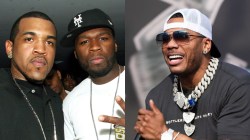No other release date in history than September 29, 1998 captivated fans’ anticipation of rap albums from its biggest and rising stars. They wholesomely served the highest quality gumbo all from the same pot, from various regions and subgenres of Hip Hop.
Twenty years ago, an era when the internet was still in its Stone Age, and Fridays weren’t the standard days for major artists’ album releases, Tuesdays at record stores were the goldmine for the music industry. While that Super Tuesday prompted dozens of rap magazines ads in preparation for the onslaught of Hip Hop heaven to be released that day, digital downloads were non-existent and there were only a handful of internet radio stations such as the short-lived 88HipHop.com and UndergroundHipHop.com to promote these albums online.
https://www.youtube.com/watch?v=MLc-yNJEjZI
Where were you on that glorious Tuesday 20 years ago? Where you even born? Let’s take a trip down memory lane.

AD LOADING...
Brand Nubian — The Foundation
The latter two albums from Tribe and the Nubians resembled the old guard from the early nineties. They were formerly innocent Native Tongue groups who had offered songs of experience and put aside their storied inner-strife an example that love is the foundation of Hip Hop. Both groups represented Hip Hop’s birthplace of New York City and passed the torch to the next generation of artists who would push the culture forward into the new millennium.
Although Foundation didn’t exactly revitalize the visibility for the NYC quartet consisting of Grand Puba, Sadat X, Lord Jamar, and DJ Alamo, the single “Don’t Let It Go to Your Head,” resulted in their (still) biggest hit to date, peaking at No. 54 on the Billboard 200, giving their album an earshot chance for old and new generations at the time.

AD LOADING...
A Tribe Called Quest – The Love Movement
After 10 years as a unit, the Tribe unexpectedly called it quits. The quartet comprised of producer/rapper Q-Tip, the late Phife Dawg, DJ Ali Shaheed Muhammad, and the “sometimes Y” member Jarobi had lots of fanfare as Afrocentric bohemian misfits that catapulted the Native Tongue crew to its apex in the early 90s. After they dropped a hat trick with three classic albums People’s Instinctive Travels Through The Paths of Rhythm, The Low End Theory, and Midnight Marauders, the group had a brewing fallout that was somewhat evident on their mediocre Beats, Rhymes and Life album in 1996.
Basically, The Love Movement was the sound of them breaking up, their penultimate album that played like rap’s version of The Beatles Let it Be. However, Tribe’s production trio of The Ummah that included J. Dilla put him on the map to become underground rap’s Dalai Lama of beat production. Years later in the 2000s and this decade, Tribe would reunite for occasional festivals and one-off concerts, but The Love Movement was their magnum coda before returning for their official swan songs on We Got It from Here… Thank You 4 Your Service in 2016.

AD LOADING...
JAY-Z — Vol. 2: Hard Knock Life
JAY-Z was poised to become rap’s next mega superstar for the MTV generation. He established his deifying title “Hova” or “Hov” for short with the name “Jay-Hova” within the inside sleeve of his Vol. 2: Hard Knock Life album. With a campy Annie-sampled chorus for “Hard Knock Life,” produced by former Queen Latifah producer/DJ Mark The 45 King, it was the summer street anthem that spoke to and from Hip Hop’s collective heart. Plus, his additional singles “Money Ain’t A Thang,” Nigga What, Nigga Who,” “It’s Alright” and “Can I Get A” featuring Amil and an upstart Ja Rule were reigning nightclub anthems and helped redefine urban contemporary radio. Plus, “Money, Cash, Hoes” featuring his longtime on-and-off rival DMX and introduced a young Beanie Sigel maintained JAY-Z’s street credibility.
JAY-Z told us on his 2003 song “Moment of Clarity” that although he wants to rhyme like Talib Kweli and Common, he sold five million copies of Vol. 2 and he hasn’t rapped like Common since. Who can blame him?

AD LOADING...
As Hip Hop began to eclipse country music for the first time as the highest sold music in the U.S., and East Coast gangsta rap and R&B had taken pop and urban contemporary radio by storm. New York producers and artists were moving the needle compared to their West Coast counterparts. They largely began to leave behind the traditionalist’s sounds of punchy drums, soul and jazz samples for lofty hi-hats and melodic synth keyboard grooves from rising star producers Swizz Beatz and Timbaland.
Mos Def and Talib Kweli Are…Black Star
The underground rap subgenre held onto that formula with those traditionalist sounds and intelligent lyricism, and battle rap. Mos Def and Kweli were ambassadors of the underground rap scene on that Tuesday. They were the flagship artists of the fledgling Rawkus who appealed to pseudo-intellectual college students, rap purists sporting backpacks, DJs and vinyl crate diggers who thrived in showing off their obscure musical tastes.
With their memorable hits and fan favorites such as the Boogie Down Productions “P Is Free”-sampled “Definition,” “Knowledge of Self,” and “Respiration” featuring Common, their sole album helped the underground rap scene grow immensely. Mos Def and Kweli’s roots in the Nuyorican Cafe open mic nights and Lyricist Lounge showcases in New York City were an extended branch from the family tree of Ultramagnetic MCs in the late 80s, the Native Tongues, Bay Area’s Hieroglyphics crew, the Good Life and Project Blowed rap scenes that produced Freestyle Fellowship and Pharcyde in the early 90s. Their album was touted for their appreciation for consciousness and b-boying. It was a coming of age moment as the scene was still finding its feet.

AD LOADING...
Outkast — Aquemini
The greatest among the albums released that day was undoubtedly Outkast’s masterpiece Aquemini. On their Raekwon-assisted “Skew It On The Bar-B,” Andre gave their mission to detract from the oncoming Bling era and hardcore popularity in rap by rapping “all the wild niggas schemin’ they gon’ jump the boy/For spittin’ all that bourgeoise, my watch, my car/I’m a star, I’d rather be a comet by far.”
The vibrant colored sketch on the album cover with their combines zodiac birth signs was a reflection of their musical direction. Outkast had evolved from hardcore street thugs that fraternized with pimps and hustlers in their Atlanta origins on their debut offering, Southernplayalisticadillacmuzik to celestial MCs on ATLiens to observant spiritual tour guides in the vein of their biggest influencers A Tribe Called Quest. Outkast was in the business of genre-bending rap music with Southern charm. They took lessons from old school rap’s past with songs such as “Da Art of Storytellin’ (Pt. 1)” (which would eventually feature Slick Rick) and added new ones with trailblazing beats from their Dungeon Family production team Organized Noize. The inimitable “Rosa Parks” gave you southern jook joint funk, “Spottieottiedopaliscious” became a timeless low-rider anthem, and “Liberation” melded southern Baptist church gospel leading listeners to answer a higher calling.

AD LOADING...
Hip Hop culture has always been rooted in competition. Yet the essence of the cultural phenomenon has always pushed itself forward with a strength-in-numbers ethos. The untimely deaths of impactful artists like Eazy-E, Tupac Shakur and The Notorious B.I.G. who conducted Hip Hop’s locomotive as a political and pop cultural force just a few years prior left the industry confused in questioning would drive it next.
https://www.youtube.com/watch?v=wK2IwS2sv94
https://youtu.be/p4aN6jJIDsw
A then-nascent XXL magazine had helped organize and defined that day as “The Greatest Day In Hip Hop History.” Its cover boasted throngs of Hip Hop luminaries and artists of all eras to mark the unity, love, and perseverance on a stoop in Harlem. It was a 40-year reprisal of Gordon Parks’ famous “A Great Day In Harlem” photo with a multitude of jazz legends in the same location.

AD LOADING...
After 25 years of building the culture from a mere cottage industry to a billion-dollar cash cow, and waiting for the haze of gunsmoke to settle from Hip Hop’s media-infused Civil War in the mid-90s, the answer was connected to its everlasting party mantra.
[apple_news_ad type=”standard”]



